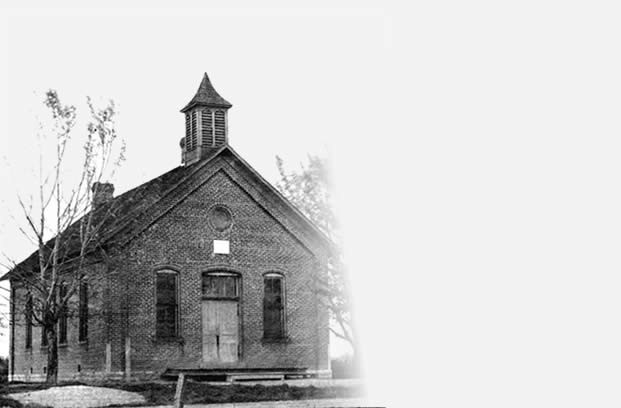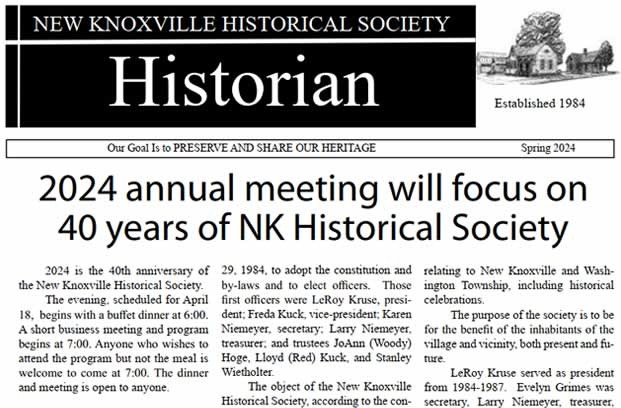Mrs. Anna Stalder McCullough of Shinbone Tells of Early Days in That Community Which Got Its Nickname From Fight Between Two Men Named Shinn and Bone
They write “Chicago U. S. A.” or “New York U. S. A.” But if you gave your address as “SHINBONE, U. S. A.” Uncle Sam’s postmasters would be apt to send your letters to the Dead Letter Office. And that would be that. But Shinbone is a community and locality as real and definite as Chicago or New York. Of course there isn’t quite as much of it. Mrs. Anna Stalder McCullough lives there and so do a lot of other readers of the Evening Leader. They look forward to reading the Living Biographies in the Saturday editions, and some of the folks have clipped every last one of them. But let Anna Stalder McCullough tell her story.
Anna was born June 15, 1873 at St. Marys and so will be 78 on her next birthday. Quite a youngster I’ll admit,--compared to her 100 year old aunt Mrs. Theresa Hauss of St. Marys, and her 95 year old aunt Mrs. Elizabeth Stalder, from the same town. When Anna was old enough to go to school her parents lived just east of St. Marys and she attended the Snethkamp school until she was 14 years old. Then she started working for the neighbor taking care of the household when new youngsters (which had a habit of putting in their appearance regularly) arrived. At the age of 16 she started working in a similar capacity at the Charles Limbacher residence and continued there until she was 18. Then her grandfather and grandmother, -- Mr. and Mrs. Chris Clay of Shinbone fell victim to the infirmities of life and decided that their grand-daughter Anna would be just the person to minister to their needs. And they surmised rightly. Anna packed her suitcase and migrated to Shinbone, 10 miles south-east of St. Marys, now on R. R. 3. There Anna fulfilled their expectations and all were happy with the new arrangements. They attended the Albright Church in the neighborhood, Anna going with them. “Grandfather was a full-blooded Scotchman, my mother German.”
After she had been there about a year she had become acquainted with other young ladies in the community. One of them was named Linnie Diegel. The latter invited Anna Stalder to go to Church with her at Shinbone one Sunday morning. After Church Linnie’s friend Anna McCullough invited both Linnie and Anna to the McCullough home for Sunday dinner. “My parents are not at home,” Anna McCullough had added. Both girls accepted the invitation. But Anna didn’t tell the girls that her brother John McCullough (who had also been at Shinbone Church that morning) would be at home. Well,--Anna Stadler and John McCullough sat across the table from each other that Sunday noon. They had a wonderful time. John had a mustache, a cute little thing, which somehow gave Anna the giggles. Everytime she looked at it the giggles overtook her. Likewise the other two girls. Soon thereafter John asked to take Anna Stalder home after some Shinbone function. Anna acquiesced. Soon it got to be a habit. They would walk those two miles, sometimes in the dark, from her grandparents home to and from Shinbone. One night John asked haltingly--“Anna—if –if –if I should ask you to marry me—what –eh – uh – what do you suppose you would answer?” Fortunately it was dark and he couldn’t see her blush. This was what Anna had been waiting for. For the life of her Anna can’t remember what she replied, but they settled it then and there, even setting the date of their wedding.
The wedding day finally arrived and scared Anna almost to death. They were to be married at John’s home on Sunday afternoon. But the preacher sent word that he had to be in Celina in the afternoon and if they wanted to be married that day it would have to take place right after the morning Church service. So Anna and John attended Church, as did also those who were to be their attendants—smiling to themselves at the deep happy secret of what was to take place after church. “But someone snitched on us. When Church was over, everybody “hung around.” They wouldn’t leave and they wouldn’t leave. So the entire congregation stayed for our wedding. I was so nervous and excited and scared, I can hardly remember what took place.”
They moved into a house near Shinbone thereafter. In November tragedy struck. Their house burned down and all their clothes with it. “There was an abandoned log cabin on my father-in-law’s farm, which was being used as a sheep stable. John and I agreed that it was both big enough and good enough for us if it were cleaned up. Word got around and all the neighbors came for a cleanup party. We cleaned it all up, they helped us get started house-keeping again and we lived there 4 years. Our two oldest daughters were born there.” Thereafter they built and moved into their own house, the present Kermit McCullough residence. Today Mrs. McCullough lives in the house next door, in a quiet shady setting, where she takes care of her garden, of her more than 100 chickens, and where her grandchildren come in and out and so break the monotony of living alone since her husband—with whom she lived happily for 56 years—departed this life Aug. 20, 1949. Shinbone, like Walnut Grove, is a little community centering around the church and school. It is a United Brethren Church. The school has since become a machine shed. They never had a store. But they had, and still have a blacksmith shop. This was started by Mason Smith and is today operated, on a small scale, by his son. We asked Mrs. McCullough how Shinbone got its name. She replied—“It had something to do with a family by the name of Shinn” she said, but she did not know details. Later we got busy on the telephone. Mrs. Elizabeth Kruse Opperman (of Shinbone) was able to supply the missing information. “Two men got into a fight near here. One was named “Shinn” and the other “Bone.” Since then they called it “Shinbone!” That happened over 60 years ago.
Mrs. McCullough told about the social life of Shinbone which centered around church and school. Special events included Church revivals, school socials, entertainments, spelling school, taffy pullings, quilting parties, and box socials. She laughed heartily as she recalled an amusing evening. “I had just been married. I took a box to the social and my husband didn’t get to see it before hand. So another man bought it. The proceeds were to be for the Church. The man who bought it was also a married man and he had a lot of children. Well,--no sooner had he sat down with me in the seat than all his children came and stood around us. So we gave nearly everything in the box to the children. They were hungry as bears. Then there was another amusing incident. Santa Claus was to come to an entertainment. He was a chubby man from the neighborhood. But he misjudged the size of the opening through which he was to come into the room, and when he tried to get in he got stuck. Everybody howled.”
She and her husband were active in their Church all their married life. He even taught his class the Sunday before he died. She is still a teacher, is in church every Sunday, and heartily interested in its welfare. “The folks around here are all good neighbors. We each tend to our own business, but when anybody needs help, everybody is right there,” she says. She loves her church and her heart’s prayer for humanity is “O Lord, Thy Kingdom come!” She recalled incidents out of the school life of the community. “One day the teacher whipped 18 boys in one day.” And what could have induced such mass punishment? “Well, the boys were mad at the girls and snow-balled them at noon. The girls, for protection, took refuge in a certain little white painted building back of the school, marked “Girls.” The boys kept threatening them with snow balls whenever they tried to come out, and so kept the girls in there all noon. The teacher whipped every one of those boys, and,--I think it served them right.”
There were numerous anecdotes regarding life at home with their eight children. “One summer the boys wanted a billy goat. Our neighbors knew about it and one day one of them called up and said that he had one that they could have, “free for nothing.” My husband and I gave in, and they went and got the goat. We put it on our screened-in-porch and he immediately butted himself through the screen in the door. Then we put him into the summer kitchen. There were several bags of flour in there. He butted the flour sacks all to pieces and the flour was just all over. It looked as if the place was on fire the way the flour dust came through the cracks. One day he actually climbed in our old Ford. We had the curtains on, and he butted right through the curtains. Well, that was all the billy-goat that we wanted. After that even the boys were convinced that we should get rid of it. So we gave it to still another neighbor.”
Her 7 living children are Beatrice (Mrs. Harry Kuntz) of Wapakoneta; Ida (Mrs. Walter Kruse) of Anna; Bernard, Leon, and Kermit around Shinbone; Lydia (Mrs. John Tabler) of Wapakoneta; Pauline (Mrs. Forest Opperman), Shinbone. One daughter, Evelyn, died of typhoid in 1930 at the age of 16. She has 10 grand-children and 6 great-grand-children. Her 3 brothers and 1 sister are still living. They are Sam Stalder of St. Marys; LeRoy of Miamisburg, Ohio; John, who lives in Indiana, and Louisa (Mrs. Clyde Meyers) of Celina. Anna McCullough is the oldest.
“My children are wonderful to me,” she said. “Several years ago we celebrated our wedding anniversary on a Sunday. While my husband and I were in Church the children moved in a complete new living room suite and rug, their gift to us. We didn’t know it till we came home from church. “That’s just like them,” she said gratefully. Her grandchildren like to visit her and she is glad to have them come. “It helps to break the loneliness,” she said.
Since writing the foregoing Mrs. McCullough contacted us and imparted the following additional information,--“The real name of the Shinbone Community is “Olive Branch.” She corroborated the information given by Mrs. Opperman regarding the SHIN—BONE fight. She further related a hair-raising episode dating back to the days when their children were small. “In our farm yard we had a cow with a new calf. I had to go to the neighbors for something and when I came back the cow had one of my young sons under foot and was trampling him. I screamed and got a stick and beat that cow. Then the cow took after me and my son got up and ran away. But the cow got the best of me, turned on me and had me under foot. Just then my brother-in-law came along. He grabbed a pitch fork and went after the cow. Now the cow turned on him, and I got up and ran away. The cow chased him into the gravel wagon. But luckily, neither my son or I received anything more than a lot of black and blue spots. That cow was really a bad one.”
NOTE: The home that Mr. and Mrs. McCullough built, and which their son Kermit and his wife occupied at the time of the interview, is located at 10212 Knierim Road.
Living Biographies
by Andrew Kay
In 1949 and 1950, Reverend Edwin Andrew Katterhenry (1900-1963), a minister and a native of New Knoxville, wrote the “Living Biographies” feature for the St. Marys Evening Leader under the pen name of Andrew Kay. These articles consisted of interviews with aging citizens, many from New Knoxville and St. Marys, relating their experiences from their younger days. After Rev. Katterhenry passed away in 1963, his widow, Florence Katterhenry returned to New Knoxville to live out the remainder of her years until 1982. For those of us who are grandparents today, we remember her as “Mrs. K”. In the final “Living Biographies” article Andrew Kay wrote about himself, thus revealing his identity to the general public.


